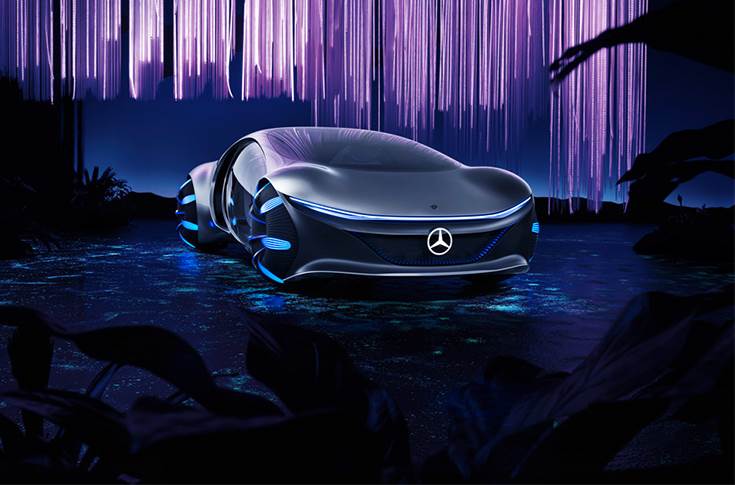During the keynote speech at the CES 2020, Ola Kallenius, chairman of the board of management Daimler and Mercedes-Benz talks on the topic ‘Sustainable Modern Luxury – Next Chapter’.
After his speech, he also unveiled the new concept car, the Mercedes-Benz VISION AVTR.
Here are some key points from the speech-
“Where do we take it from here?” I guess that’s the core question of every CES. To us at Mercedes, that’s way more than pairing a smartphone to your car entertainment system. What I want to focus on is the bond between human and machine. Tech in a car is all about the interface. From wooden sticks to switches and buttons, all the way to our MBUX voice assistant – such as in our all-electric EQC. You can ask Mercedes how your favourite sports team recently performed or what the weather looks like on the way to your favourite ski resort. Later this year, you will also be able to control your smart home from the road. And the next step in the evolution of the interface at Mercedes is just around the corner: the first truly intuitive gesture control. Since we believe the interface is key to providing customers seamless access to opportunity – without being lost in complexity. The more natural the connection gets, the better. That’s especially important for our business because folks build highly emotional relationships with their cars. One idea we want to show is based on a biometric connection between the car and the driver. The car recognises the human driver’s heartbeat and breath so man and machine literally merge into a fully intuitive experience.
Bringing luxury and sustainability together
Global demand for individual mobility is set to grow. Our 2019 sales figures prove that with the ninth record year in a row – and the fourth consecutive year as the number one car brand in our segment. Our home turf, the luxury car market, is projected to outgrow the industry average. People just love their individual freedom to instantly go where they choose when they want. That’s why our perspective is clear: we understand the boundaries of our planet. But we don’t want to add new boundaries to mobility. In other words, fewer cars are not the solution. Better cars are. Yes, the continued growth of mobility means a corresponding growth in the use of resources. But we have to change that. Our approach is decoupling. Decoupling the Mercedes way, however, means that we’re decoupling volume growth from resource consumption. Our tools to achieve that are sustainable innovation and technology.

We have three main levers to succeed: reduce, reuse, recycle – with the ultimate goal of fully closing the loop, from value chain to value cycle. For us, step one is reducing our CO2 footprint: we’ve started that under the headline of ‘Ambition 2039’. We’re aiming at carbon-neutral vehicle production, growing the share of electric vehicles sold and, finally, having a carbon-neutral new passenger car fleet by 2039. We want to address this in a holistic way. That includes driving our suppliers and partners to comply with our objective of carbon neutrality. Next, we’re focusing on resource preservation. By 2030, our car-production plants are set to reduce their total water consumption by a third per vehicle. That adds up to hundreds of millions of litres of drinking water. The ultimate goal, of course, is a fully closed water cycle. That means our plants reuse a lot of the process water throughout the factory. We have initial projects underway in several plants around the world. By 2030, our car production plants are set to reduce the energy they consume by more than 40 percent per vehicle. Today, our plants in Jawor, Poland, as well as in Hambach, France, already run entirely on renewable energy. By the end of 2022, all plants in Europe will be carbon-neutral run on renewable energy. The rest of the world will follow. And we’re also reducing waste. By 2030, our factories will also reduce waste per vehicle by more than 40 percent.
As we keep expanding our electric vehicle lineup, the battery is a major lever. A great example of reusing electric car batteries is giving them a second life as stationary energy sources. Ultimately it’s about closing the loop in a circular economy based on recycling. Every Mercedes passenger car is recyclable by 95% today. And this standard also applies to our electric cars. Battery recycling is happening, but there is room for improvement. What we are aiming at are 100% recyclable batteries.

At the same time, we keep encouraging our partners and suppliers along the value chain to further increase the usage of secondary materials like steel, aluminium and polymers to foster circularity. Just as we do in reducing our CO2 footprint.
Mercedes-Benz VISION AVTR – Advanced Vehicle Transformation
It is a car that is inspired by the fascinating world of the Hollywood film, Avatar. The car comes without wooden sticks, plastic knobs or a steering wheel. The VISION AVTR also showcases new ways of moving people through the environment – sideways, like a crab, for instance. It takes sustainability to new levels through a fully recyclable battery, which is based on organic cell chemistry and doesn’t need materials like nickel or cobalt.

This means in the future, the battery could be compostable while also offering incredibly fast charging capabilities. This show car also uses many recycled and sustainable materials inside the cabin, like vegan ‘DINAMICA’ leather or Karuun woods made of fast-growing rattan. This car showcases new ideas of communicating – for instance by using its bionic flaps.
Check out the full keynote speech here
/news-international/daimler’s-ola-kallenius-‘fewer-cars-are-not-the-solution–better-cars-are’-45152 Daimler’s Ola Kallenius: ‘Fewer cars are not the solution, better cars are’ At the launch of the Mercedes-Benz VISION AVTR, Daimler’s chairman of the board of management talks about synchronising luxury with sustainability and gives us a glimpse into how the future of mobility will be from Mercedes-Benz https://www.autocarpro.in/Utils/ImageResizer.ashx?n=https://www.autocarpro.in/userfiles/d92239b3-f61f-44ec-9afa-a34b60315ab5.jpg
